About the Public groups and multinational business tax certainty findings report
This report sets out the key findings about how we provide tax certainty to public and multinational businesses for the 2020–21 to 2024–25 financial years.
Providing tax certainty is a critical part of our approach to public and multinational businesses to help them comply and prevent disputes. The effectiveness and importance of these programs is evidenced by their significant uptake as outlined in this report.
We provide different products to allow public groups and multinational businesses to achieve certainty over both their domestic and international transactions.
The Advice and Guidance (A&G) program provides tax certainty through the provision of advice and guidance in a range of forms to taxpayers. The A&G program assists taxpayers understand how the law applies to their circumstances, including before they enter a transaction or lodge their return.
This year, the findings report also covers our Advance Pricing Agreement (APA) program. The APA program provides a mechanism for managing and mitigating the taxpayer’s transfer pricing risk by providing greater certainty on a prospective basis over cross-border transactions.
This report details:
- insights on the requests for tax certainty that we receive
- observations about the time it takes us to provide our service offerings and the key factors that impact our timeliness, and
- for the A&G program; our key findings about the outcomes of our engagements
- for the APA program; observations and insights regarding trends and changes to the APA population composition and demographics.
The insights from this report are used by us as part of our commitment to continuous improvement of the programs. We also use the findings and observations to inform how we can better educate and assist taxpayers to obtain tax certainty through the most effective and efficient use of both programs.
About the public and multinational business advice and guidance program
The public and multinational business advice and guidance program (the A&G program) is a specialised service that:
- delivers high quality advice for complex transactions undertaken by public and multinational business taxpayers on a range of transactions, including mergers and acquisitions, restructures, financing arrangements, or cross-border dealings
- provides certainty about the tax outcomes for transactions where a ruling, advice, or other guidance is provided to help taxpayers comply with their tax obligations from the outset, and
- engages closely with internal and external partners to identify issues early through the early engagement process, facilitating timely and collaborative resolution of tax issues to assist in minimising future compliance costs.
Advice and Guidance products provided as a part of the A&G program are outlined in Practice Statement Law Administration PS LA 2008/3 Provision of advice and guidance by the ATO.
Key insights – advice and guidance program
As a demand driven program, the volume and nature of advice requests we receive reflects market activity as well as legislative changes. Key examples are the effects of macro-economic trends, such as interest rates on merger and acquisition activity, and the cyclical nature of withholding tax exemption requests to the A&G program.
Most applications to the A&G program are made via advisers – this reflects the transactional nature of many of the arrangements on which advice is requested. The number of requests lodged directly by taxpayers has generally been trending down, although we saw an uptick in 2024–25 associated with withholding tax exemption requests.
The complex and often precedential nature of our work, with broader system-wide impacts, has seen certain engagements run for extended periods. We also found a strong correlation between cycle times and the time taken to respond to our requests for information. We continue to work on internal initiatives to reduce cycle times and we saw a small reduction in cycle times in 2024–25.
The outcome of private and class ruling requests have been stable over the years. Most rulings conclude with favourable advice providing binding tax certainty for those using the A&G program. A small number of rulings don't proceed, and a very small percentage provide unfavourable views, although these taxpayers can also be better informed about how to comply.
Early engagements trended up slightly in 2024–25 after several years of decline, attributed to changes in the topics requested. We found the early engagement program continues to improve the likelihood of a favourable ruling, reflecting the benefits of discussions with us before a formal ruling is lodged and a transaction is implemented.
Program observations – advice and guidance program
This report is based on aggregated data for the 2020–21 to 2024–25 financial years for cases completed within the A&G program.
Requests for advice are not one-size-fits-all and it is difficult for data alone to capture the different complexity of each engagement. Some transactions may require more than one ruling to be issued, particularly when there are multiple parties to transactions each requiring individual certainty, or there are separate issues that need to be addressed independently.
The findings in this report are primarily based upon the number of ruling and guidance products completed each year, rather than the number of underlying transactions or schemes to which those products relate.
Report findings should be considered alongside broader macro-economic conditions and external influences. Changes in demand drivers for advice and guidance impact the type, nature and complexity of advice and guidance requested by our clients.
Receipts
Overall receipts
Figure 1: Total requests received and completed 1 July 2020 to 30 June 2025
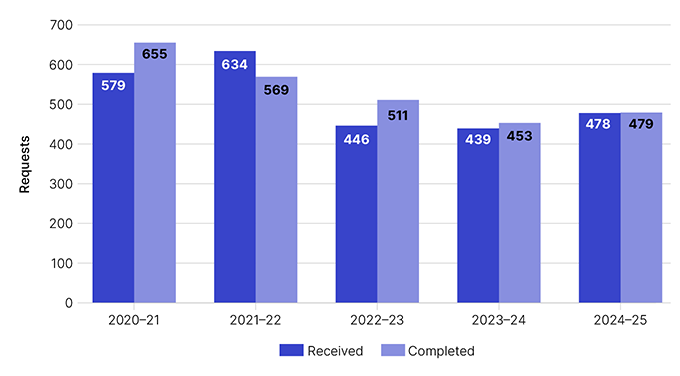
You can also view data for total requests received and completed in Table 1.
The number of requests received in 2024–25 was approximately 9% higher than in 2023–24. The overall volume of requests received appears to have stabilised following the volatility of the COVID-19 years, although patterns differ across product types and individual topics.
Figure 2: Requests received by product type 1 July 2020 to 30 June 2025
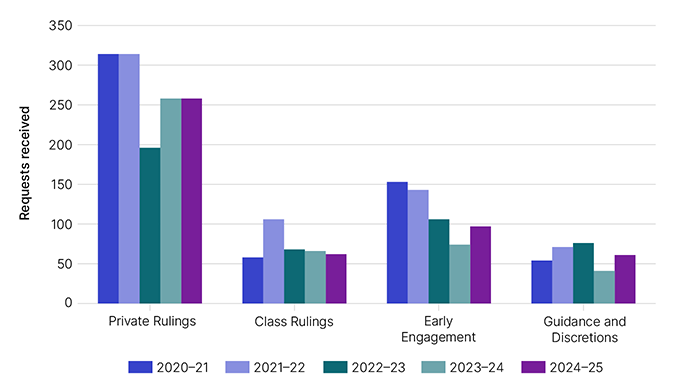
You can also view data for requests received by product type in Table 2.
Requests for private rulings have remained relatively stable after increasing from their 2022–23 low in 2023–24. Requests for early engagement have also increased after several years of sustained declines, and requests for guidance and discretions have also increased after almost halving in 2023–24.
The differing trends across product types can in part be attributed to movements in some of the A&G program’s most commonly requested topics.
Receipts by topic
Figure 3: Requests received by top 5 topics 1 July 2020 to 30 June 2025
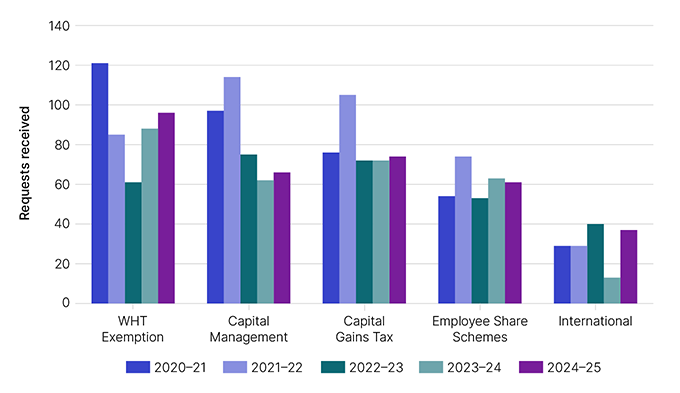
You can also view data on the top 5 topic requests received in Table 3.
Withholding tax exemption requests remain the most frequently requested advice topic, primarily reflecting the demand from foreign superannuation funds and sovereign entities reapplying for an exemption. These withholding tax exemptions are a major contributor to the volatility in private ruling requests observed in figure 2, accounting for around 30% of the reduction in private ruling requests in 2022–23 and 55% of the increase in 2023–24.
While overall capital management requests have increased only slightly after several years of decline, early engagement requests relating to capital management issues increased by 47% in 2024–25. Overall early engagement request volumes are sensitive to changes in capital management receipt volumes as they typically account for 22–25% of early engagement requests in any given year.
The 2024–25 increase in capital management early engagement requests may indicate that we will see an increase in capital management ruling requests throughout 2025–26, however capital management requests are closely linked to economic conditions and merger and acquisition activities. We have also seen a substantial decline in requests for advice related to capital notes issuances following changes to their regulatory treatment.
Requests relating to international issues have rebounded after a large drop off in 2023–24. Much of this can be attributed to an increase in residency and competent authority requests related to Australia’s double tax agreements, although there was also an increase in other assorted international issues.
Changes to legislation have also affected requests for certain topics. There were fewer off-market share buy-backs for listed companies after aligning the tax treatment of off and on-market share buy-backs. On the other hand, there have been new requests relating to the changes to the rules relating to thin capitalisation and franked distributions.
Receipts by taxpayer population
The Action Differentiation Framework (ADF) represents a strategic methodology for engaging with public entities and multinational corporations based their place in the framework.
Our ADF population categorisation was updated in the 2024–25 financial year. This report uses the new framework and so is not directly comparable to figures included in previous reports. The new ADF categories are:
- Top 100
- Top 1,000
- Large risk strategy – large market entities which are not covered by the Top 100 or Top 1,000 program
- Medium and emerging risk strategy – all other public and multinational business groups.
The A&G program also receives requests from clients outside of these ADF populations, particularly sovereign entities and foreign superannuation funds.
Figure 4: Requests received by taxpayer population 1 July 2020 to 30 June 2025
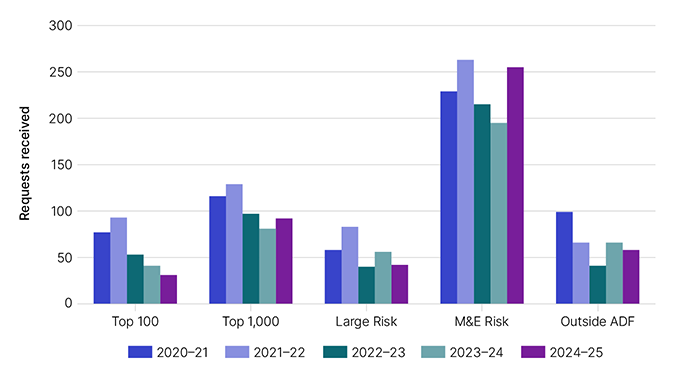
You can also view requests received by taxpayer population in Table 4.
There has been a continued downward trend in receipts from the Top 100 population since 2021–22. This has coincided with the previously discussed decline in capital management receipts; Top 100 entities account for approximately 30% of capital management requests. The downward trend in receipts from the Top 100 program could also be attributed in part to the ongoing maturity of the ATO’s Justified Trust program.
Requests received from the Top 1,000 and large risk markets have remained relatively consistent since 2022–23, while volatility in requests received from outside the ADF and medium and emerging risk strategy categories reflects reclassifications as a part of the updated ADF framework.
Figure 5: Requests received by most recent income tax assurance review rating 1 July 2020 to 30 June 2025
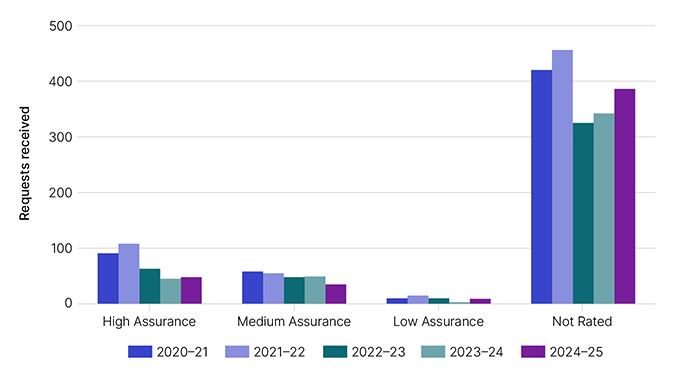
You can also view requests received by most recent income tax assurance review rating in Table 5.
Figure 5 visualises requests received by the A&G program based on a taxpayer's most recent assurance rating under our Justified Trust program. Requests are grouped by the taxpayer's most recent assurance result achieved in a Justified Trust review, such as a Tax Assurance Review, Streamlined Assurance Review or Combined Assurance Review. A taxpayer's most recent Justified Trust review may not have taken place in the same year their request was received.
Many of the A&G program's clients fall outside the scope of the Justified Trust model, which highlights the important service the A&G program provides for taxpayers not engaged under our Justified Trust programs to obtain certainty over their tax affairs as part of their good governance requirements.
There has been a consistently downwards trend in requests from taxpayers who have achieved a high assurance rating since 2021–22. This mirrors the overall decline in requests to the A&G program, particularly those related to capital management, which accounted for more than 50% of requests lodged by taxpayers with a high assurance rating in 2021–22 but only 30% of requests in 2024–25.
The decline in requests from taxpayers with a high assurance rating may also indicate these taxpayers assess that they have sufficient certainty regarding their tax outcomes based upon the regular and ongoing Justified Trust review processes, particularly those that are also Top 100 clients.
Receipts by use of advisor
Figure 6: Requests received by advisor type 1 July 2020 to 30 June 2025
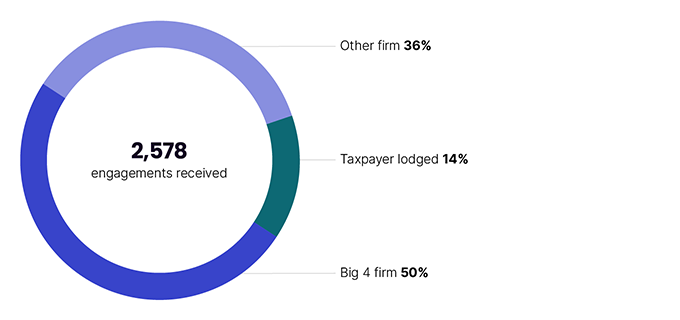
Advisors play a key role in the A&G program, with 86% of requests for advice received through an advisor.
Figure 7: Requests received by advisor type 1 July 2020 to 30 June 2025
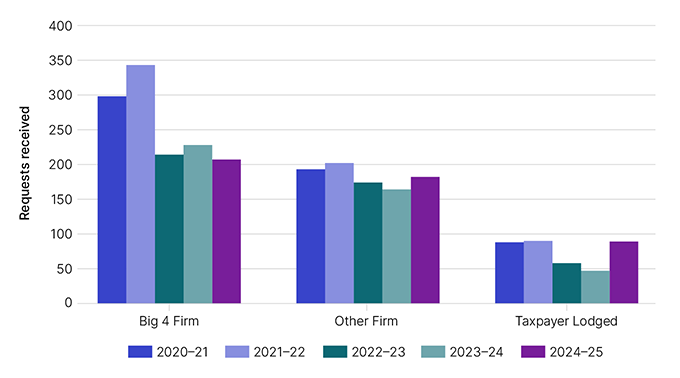
You can also view requests received by advisor type in Table 6.
The number of receipts from Big 4 was slightly lower in 2024–25, while requests received from other firms and directly from taxpayers increased, attributed in part to an increase in withholding tax exemption requests.
Timeframes and information requests
Performance against service commitments
The A&G program is governed by the ATO’s service commitments, which set out the level of service to expect when dealing with us. As a part of these commitments, we agree to meet the following targets in 80% of private and class ruling cases:
- Respond to enquires within timeframes – we will complete rulings within 28 days of receiving all required information.
- Keep clients informed of status or delays – if we find that a request raises particularly complex matters that will take more than 28 calendar days to resolve after receiving all the necessary information, we will aim to contact the applicant within 14 calendar days to negotiate a due date.
Figure 8 (Table): Private ruling and class ruling performance against service commitments 2024–25
|
Product
|
Timely
|
Keep me informed
|
|
Private ruling
|
96%
|
98%
|
|
Class ruling
|
96%
|
96%
|
Program completion timeframes
Our performance against service commitments doesn’t provide the full picture of the time taken to complete a request for advice or guidance in the A&G program. Our service commitments don’t apply to discretions or early engagement products, and don’t account for the complexity of matters. Complex matters often require multiple stakeholder engagements and additional requests for information, which extend the service standard timeframes as further issues are identified in these engagements.
Figure 9 shows the median number of days taken to complete a request in the A&G program both overall and by product type. In order to provide the most comprehensive picture of cycle times, Figure 9 combines the time taken to complete early engagement requests that weren’t withdrawn with the time taken to complete their subsequent ruling or guidance products.
Figure 9: Median total days to complete requests by product 1 July 2020 to 30 June 2025
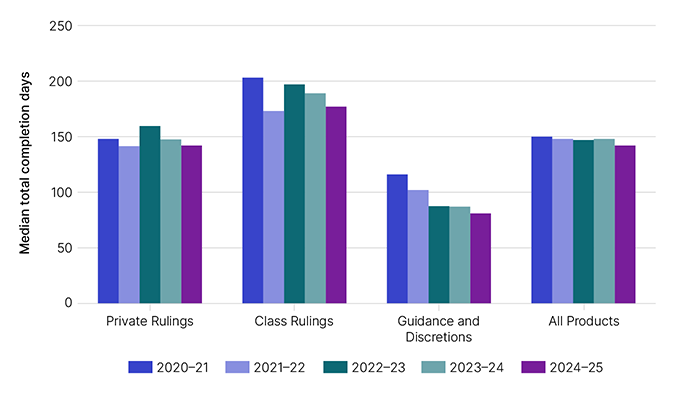
You can also view data on median total days to complete requests by product in Table 7.
The total median time taken to complete a request in the A&G program fell slightly from 148 days in 2023–24 to 142 days in 2024–25. Class rulings consistently take longer to complete than other products due to the additional consent, internal review and publication processes that are required for these products. In addition, we don’t publish class rulings until the relevant schemes have been entered into, which means the completion of many class rulings that have been effectively resolved from a technical standpoint can often be delayed by factors outside the control of the A&G program.
There is also an observed correlation between timeframes and a taxpayer’s assurance rating. Requests from taxpayers with low assurance ratings take longer to complete than those from taxpayers with a medium or high assurance rating. However, it's important to note that while a taxpayer’s assurance rating may affect the time taken to complete a request, it doesn't affect the likelihood of receiving a favourable outcome.
Timeframes by topics
Request completion times vary by topic, with some request types taking longer to complete than others. We have also observed that it takes longer to resolve matters where Part IVA is considered in addition to the substantive provisions in question.
Figure 10: Private ruling, class ruling and guidance requests completed 2024–25 – difference from median total completion days by selected topic
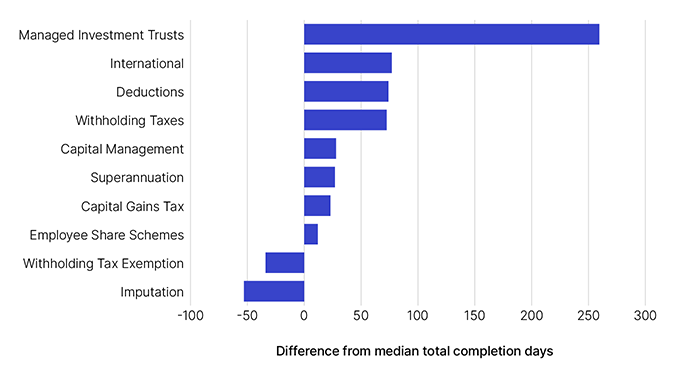
Note 1: This chart only includes topics with 10 or more completions in 2024–25.
Note 2: Withholding taxes requests involve treaty, royalty and entity-related questions.
You can also view data on the difference from median completion days by topic in Table 8.
Cycle times may increase for several other reasons, including delays in coming to a position on complex or precedential issues within the ATO – such as the time taken for the ATO to come to a position on captive managed investment trust issues – as well as delays in obtaining all the information required for us to rule.
Information requests by topic
In order to better understand the drivers of the time taken to complete requests, since 2023–24 the A&G program has started tracking the number of requests for information (RFIs) issued for each engagement, as well as the time taken to receive a full response for each request.
Figure 11: Average RFIs issued per topic 1 July 2023 to 30 June 2025
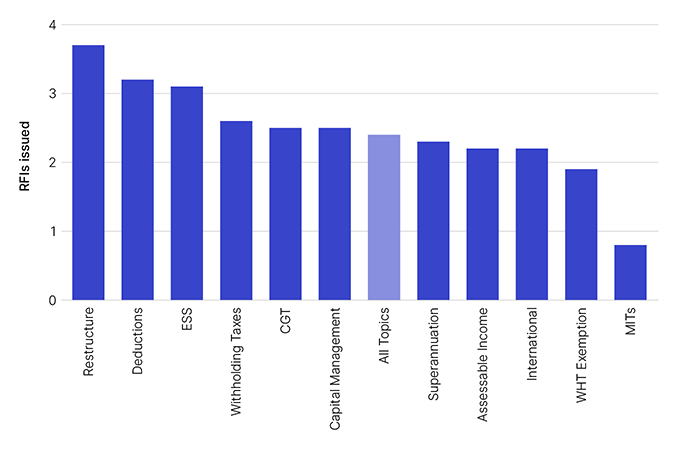
Note 1: This chart only includes topics with 10 or more completions and RFI data available since 1 July 2023.
Note 2: Withholding tax requests involve treaty, royalty and entity-related questions.
You can also view data on the average RFIs issued by topic in Table 9.
In addition to the number of information requests, there is a strong correlation between days spent awaiting responses to RFIs and total days taken to complete a request. To this end, we actively manage our cases and continually seek opportunities to provide guidance to applicants on information that should be included in ruling applications to reduce the need for repeated RFIs.
For example, in 2023–24 we released bespoke application forms for taxpayers requesting rulings in relation to sovereign immunity and foreign superannuation fund withholding tax exemptions, and the median number of days spent awaiting RFI responses fell from 43 days in 2023–24 to 32 days in 2024–25.
Figure 12: Median RFI response days and median total completion days by topic 1 July 2023 to 30 June 2025
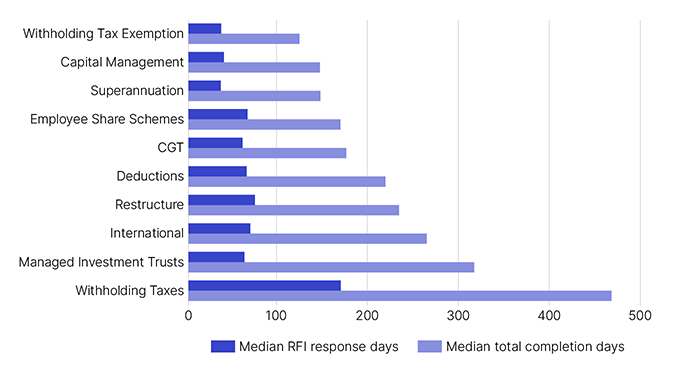
Note 1: This chart only includes topics with 10 or more completions and RFI data available since 1 July 2023.
Note 2: Withholding tax requests involve treaty, royalty and entity-related questions.
You can also view data on the median RFI response days by topic in Table 10.
Although the time taken to respond to RFIs influences our total completion times, there are also certain topics that tend take us longer to finalise. Complex transactions, such as restructures and transactions with international elements often take our case teams longer to work through.
Because of the many factors influencing the time taken to complete our requests, we continue to improve our analysis of cycle times to have better visibility over barriers to the progression of our work and to identify internal and external opportunities to provide more timely advice and guidance.
We also consult with external stakeholders on recurring issues and topics in the A&G program and contribute to the development of new and improved public advice and guidance products with the aim of reducing the need for taxpayers to seek a binding ruling.
Outcomes
Overall ruling outcomes
Figure 13: Outcome of private ruling and class ruling requests 1 July 2020 to 30 June 2025
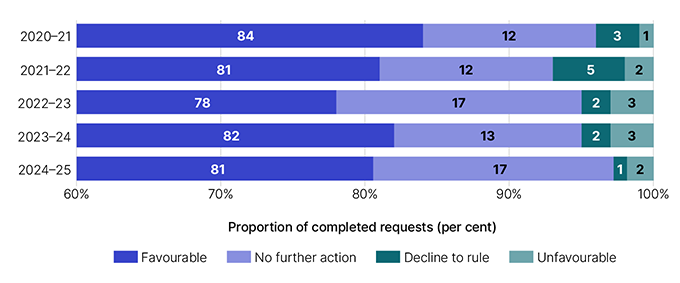
Note: The x-axis for this chart has been truncated to allow smaller categories to be more easily visualised. This chart won't add up to 100% due to rounding.
You can also view data on the outcome of private ruling and class ruling requests in Table 11.
The percentage of class and private rulings with favourable outcomes has remained around 80% for the past 4 years, with only 2% resulting in an unfavourable ruling in 2024–25.
Cases where we decline to rule are infrequent. Most cases where we decline to rule occur when the applicant doesn't provide the information necessary to make a ruling or where a ruling would have limited immediate utility for self-assessment. This most commonly occurs in sovereign immunity and foreign superannuation fund withholding tax exemption cases or where the relevant transaction is too far in the future and not yet in serious contemplation.
Requests for rulings which result in no further action being required have remained relatively stable as a percentage of total ruling requests over the past 4 years. Outcomes described as ‘no further action’ include instances where it was determined a ruling wasn't required, we provided advice in another form, or where the request for a ruling was withdrawn.
A request for a ruling may be withdrawn for many reasons, commonly when the taxpayer's circumstances have changed and the proposed transaction is not proceeding. Where we provide an unfavourable decision or an application is withdrawn after we identify concerns with the applicant’s interpretation or application of the law, we may continue to monitor the relevant issue, for example as part of the applicant’s Justified Trust review.
Outcomes by taxpayer population
Despite the relative consistency of outcomes over the past 4 years, outcomes are highly differentiated across taxpayer populations.
Figure 14: Class and private ruling outcomes by taxpayer population 1 July 2020 to 30 June 2025
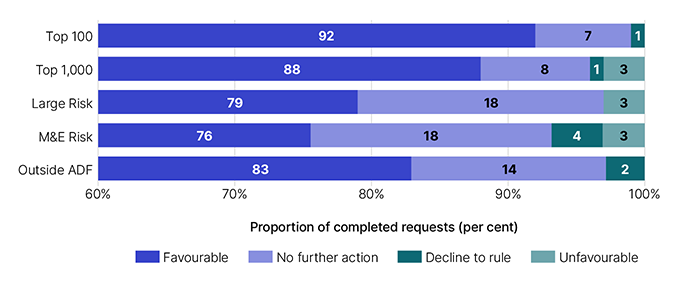
Note: The x-axis for this chart has been truncated to allow smaller categories to be more easily visualised. This chart won't add up to 100% due to rounding.
You can also view outcomes by taxpayer population data in Table 12.
Private and class ruling requests lodged by taxpayers outside the Top 100 and Top 1,000 program are more likely to result in either a withdrawn ruling request, an unfavourable ruling, or a situation where we decline to rule. This differentiation may be in part explained by differences in use of the early engagement system across taxpayer populations, discussed further below.
Outcomes by assurance rating
Figure 15: Class and private outcomes by most recent income tax assurance rating 1 July 2020 to 30 June 2024
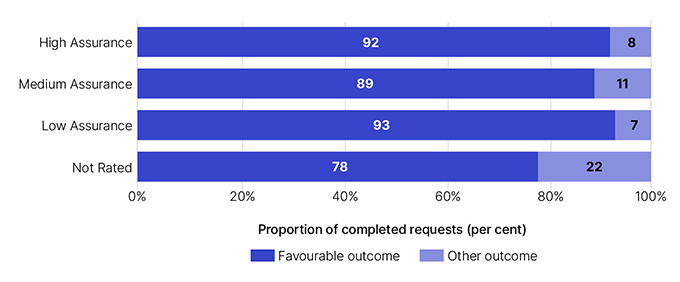
Note: Assurance ratings are based on the most recent assurance result from Income Tax Streamlined Assurance Reviews, Combined Assurance Reviews and Tax Assurance Reviews completed between 2018 and 2025.
You can also view data on class and private rulings outcomes by assurance rating in Table 13.
There is no correlation between ruling outcomes for taxpayers across the 3 assurance ratings, except that taxpayers that have not been through a Justified Trust review are less likely to receive a favourable outcome. These taxpayers are also much less likely to have gone through the early engagement process before submitting their ruling request.
Early engagement
We strongly encourage taxpayers contemplating complex transactions to seek early engagement with us before lodging a formal ruling application or implementing the transaction. Early engagement on complex transactions that starts as early as possible in the scheme implementation process ensures there is a clear understanding of the proposed scheme and the tax implications before a formal ruling application is made.
Early engagement enables taxpayers to:
- discuss an arrangement and its intended outcomes
- identify key issues and concerns and how they can be addressed
- discuss the most appropriate form of advice required and the information needed to support it, and
- expedite the ruling process by resolving issues upfront and reducing the need for further queries.
While taxpayers may decide through the early engagement process that a formal ruling isn't required, early engagement still assists taxpayers to understand the Commissioner’s view of the transaction.
Early engagement by taxpayer population
Figure 16: Class and private ruling requests completed following early engagement by taxpayer population 1 July 2020 to 30 June 2025
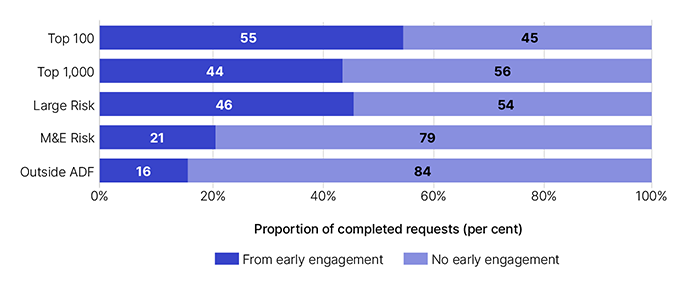
You can also view data on early engagement by taxpayer population in Table 14.
The early engagement process is used most by taxpayers in the Top 100 population where more than half of the requests for advice start as an early engagement. It's also frequently used by taxpayers in the Top 1,000 and Large Risk Strategy populations. This is likely to reflect these taxpayers’ familiarity with the A&G program and the complex nature of their transactions. Taxpayers who are a part of our Justified Trust program are also substantially more likely to take advantage of our early engagement offerings than other taxpayers.
Progression to a ruling from early engagement
Figure 17: Outcome of early engagement requests 1 July 2020 to 30 June 2025
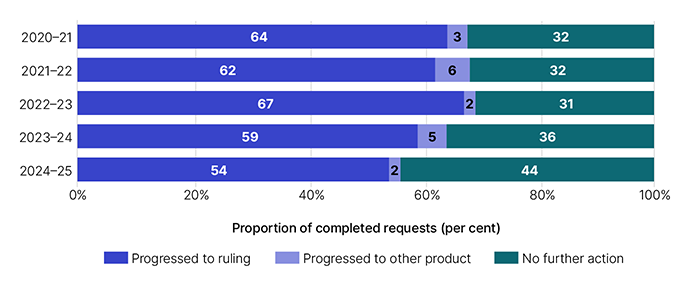
Note: This chart won't add up to 100% due to rounding.
You can also view outcomes of early engagement requests data in Table 15.
Across the years, more than half of early engagements progress to a ruling, however, a substantial portion do not. Early engagements that don’t progress are sometimes the result of case teams providing an indicative unfavourable view, but most commonly occur when transactions don't proceed or when initial analysis indicates that a ruling isn’t required. This reflects the nature of early engagements where taxpayers are speaking with the ATO early in a transaction lifecycle and about situations where there is more uncertainty about the suitability of a ruling.
There has been a slight trend for a smaller proportion of early engagements to proceed to a ruling. This could be a result of some taxpayers and advisors becoming more comfortable with proceeding directly to the ruling application stage, reserving the early engagement process for situations where there is genuine uncertainty about a ruling application.
Overall outcomes with and without early engagement
Figure 18: Pipeline of early engagement and direct ruling applications through the A&G program
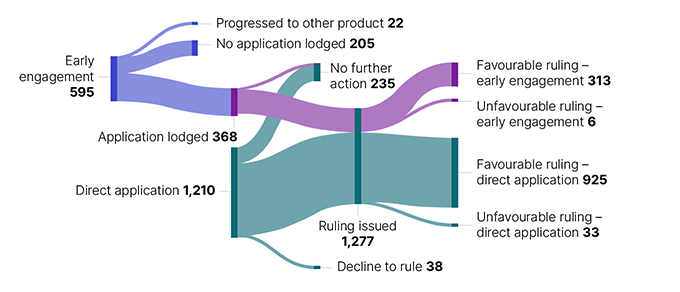
You can also view the pipeline of early engagement and direct ruling applications data in Table 16.
This pipeline demonstrates how requests for advice move through the early engagement and rulings process and their eventual outcomes. It illustrates the flow of requests for class and private rulings completed by the public and multinational business advice and guidance program from 1 July 2020 to 30 June 2025 based on whether they were initially received as early engagement requests or direct ruling applications.
Approximately 30% of our ruling requests begin as an early engagement application, while the remaining 70% come to us as a direct ruling application.
Figures 19 and 20: Class and private ruling request outcomes with and without early engagement 2024–25
Figure 19: Request outcomes without early engagement
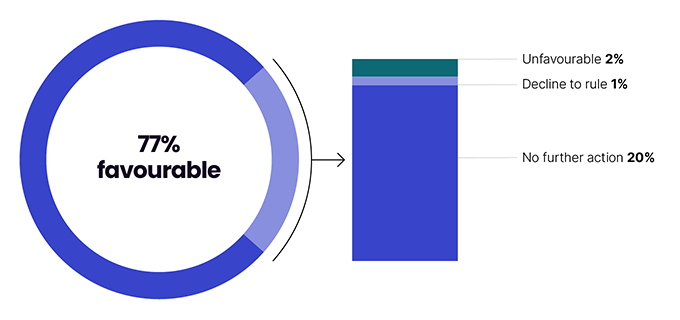
Figure 20: Request outcomes with early engagement
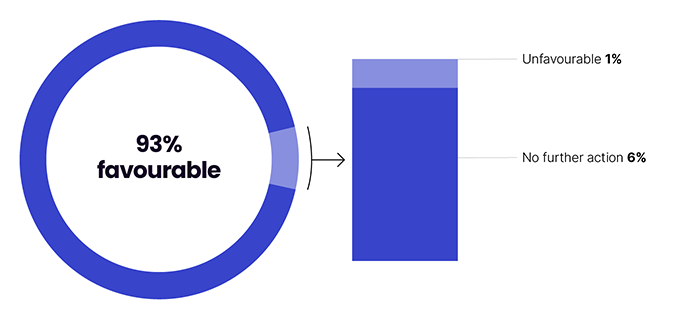
In 2024–25, class or private ruling requests that followed an early engagement were 15% more likely to result in a favourable ruling than ruling requests that weren’t preceded by an early engagement. The early engagement process also saw a reduction in the number of unfavourable rulings from 2% to 1% and the number of withdrawn rulings from 20% to 6%. We didn’t decline to rule on any class or private ruling request that came to us following an early engagement.
The higher rates of favourable rulings after early engagement should be considered with the context that a substantial portion of early engagement requests don't progress to formal lodgment. This reflects the early engagement system functioning to allow taxpayers to discuss applications that might turn out to be unnecessary or unsuitable for a ruling. Additionally, the early engagement process generally allows us to raise any concerns before transactions have occurred. For these reasons, we encourage taxpayers contemplating complex transactions to consider early engagement with us before lodging a formal ruling application or implementing the transaction.
About the public and multinational business advance pricing arrangement program
The advance pricing arrangement (APA) program is an important part of our compliance and assurance strategy, that:
- provides the opportunity for taxpayers to reach an agreement with us and other tax authorities on the future application of the arm's length principle to their dealings with international related parties
- provides a mechanism for managing and mitigating their transfer pricing risk by providing them with greater certainty on a prospective basis and reducing the potential for double taxation on their cross-border dealings when undertaken on a bilateral basis
- fosters a constructive working relationship built on mutual trust which is established through early engagement and full and frank disclosure throughout the negotiation of the APA.
The APA program is a critical element in achieving voluntary and cooperative compliance and, in turn, building trust and confidence in the tax system.
The operation of the APA obligates the taxpayer complying with requirements set out in the agreement and is subject to certain critical assumptions. These obligations are reviewed annually and documented in an Annual Compliance Report, and where those obligations are met, we are administratively bound by the terms of the APA. Therefore, we won't impose additional income tax to that payable, based on the pricing worked out under the APA on the covered cross-border dealings.
The APA generally covers a period of 3 to 5 years. It may be reviewed if trading circumstances materially change.
For further information, see our:
Key insights – advance pricing arrangement program
Recent changes to the APA program
In 2023, the ATO published the findings from our review of the APA Program. The APA program review led to a range of improvements to APA processes such as a re-focused scope, better defined entry criteria, approach to collateral issues, and other practical improvements to governance processes.
A large component of the APA program review was to ensure we had a renewed focus on transfer pricing certainty through bilateral APAs for significant cross border dealings where the double taxation risk is high.
The impact of this focus is starting to be observed based on the composition of cases within the APA Program population, as can be seen from the following data.
APA program inventory
Figure 21: Total APA population by type
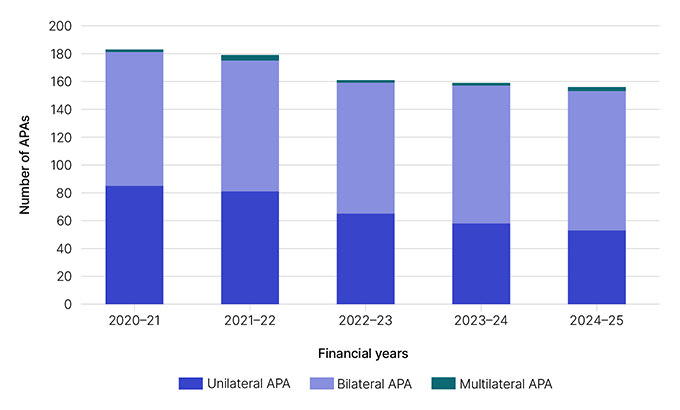
You can also view data for the APA population in Table 1.
Figure 22: APAs in place by type
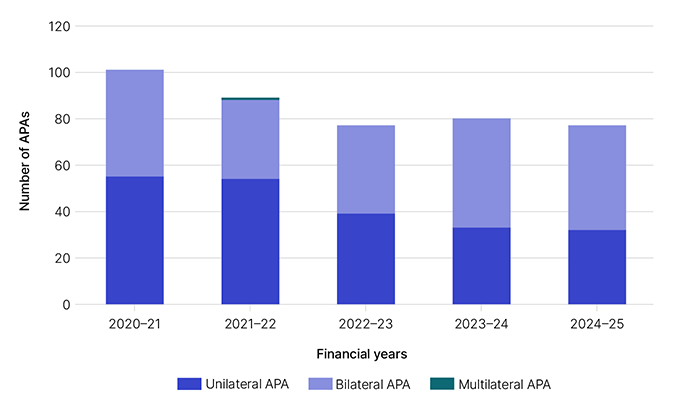
You can also view data for the APAs in place in Table 2.
As can be seen in Figure 21, the total APA population (in place and under negotiation APAs) has decreased in size over the last 5 years.
This has been driven by the reduction in unilateral APAs (UAPA) within the population, with the 2023–24 financial year being the first year that we have more bilateral APAs (BAPA) in place than UAPAs. This divergence is likely to grow as BAPA requests continue to exceed UAPAs.
This trend illustrates taxpayers’ preferences for the certainty provided by BAPAs, as well as the impacts from implementing the recommendations from the APA program review.
Figure 23: APAs under negotiation by type
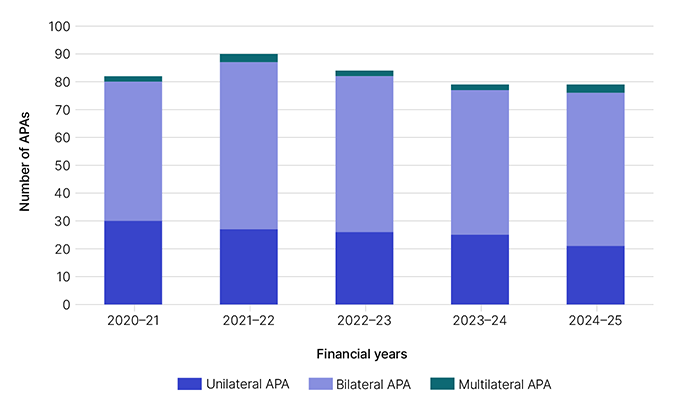
You can also view the APAs under negotiation by type in Table 3.
Figure 24: Total APA population by ADF rating
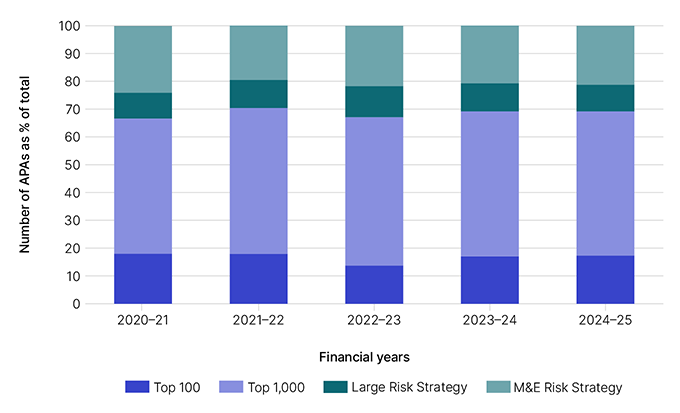
While the overall number of APAs is currently down, we believe that engagement is occurring on the right type of APAs that are most important for taxpayers and the system, with a greater focus on addressing significant transactions that are at a higher risk of double taxation.
The taxpayer demographics within our APA population continue to be consistent, with our Top 100 and Top 1,000 taxpayers comprising approximately 70% of our total APA population, reflecting the focus of the APA program on significant cross-border transactions.
Figure 25: Total BAPAs/MAPAs in population by jurisdiction (Top 10 by number of cases) at 30 June 2025
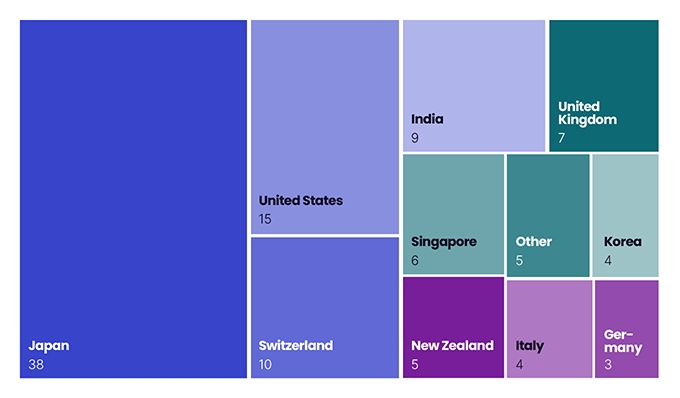
You can also view data for the BAPA/MAPA population by jurisdiction in Table 5.
Japan and United States continue to be our largest treaty partners within the APA program. Inventory with Switzerland, India and Singapore also continues to grow.
‘Other’ represents jurisdictions where we have 2 or fewer BAPAs with that jurisdiction. We also note that, while the above data relates to both BAPAs and MAPAs, we currently only have 3 MAPAs under negotiation, all of which are with the US and the UK.
APA requests
Figure 26: APA EE requests by type
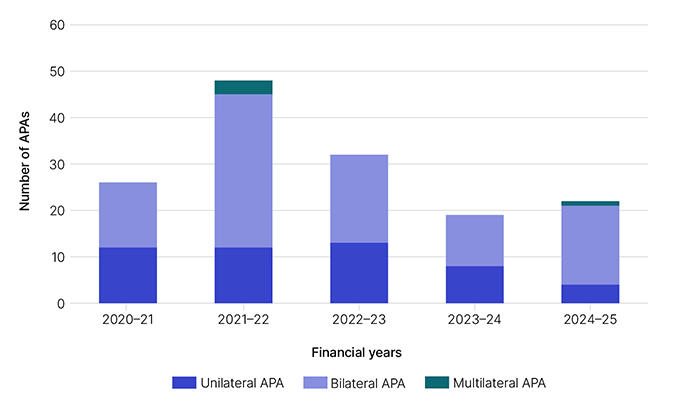
You can also view data for APA EE requests by type in Table 6.
Figure 27: APA EE requests by New/Renewal
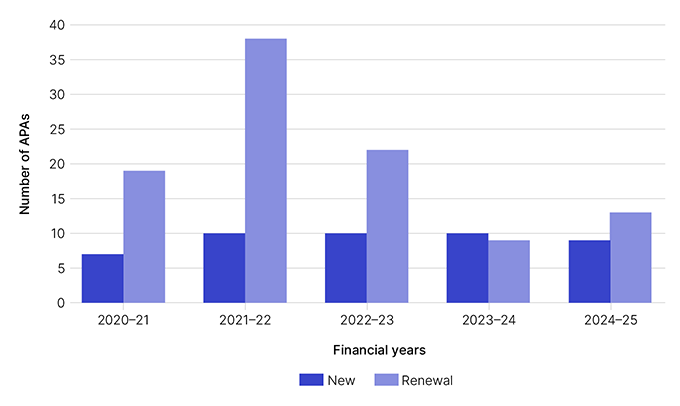
You can also view data for APA EE requests by New/Renewal in Table 7.
Figure 28: APA Renewal EE requests
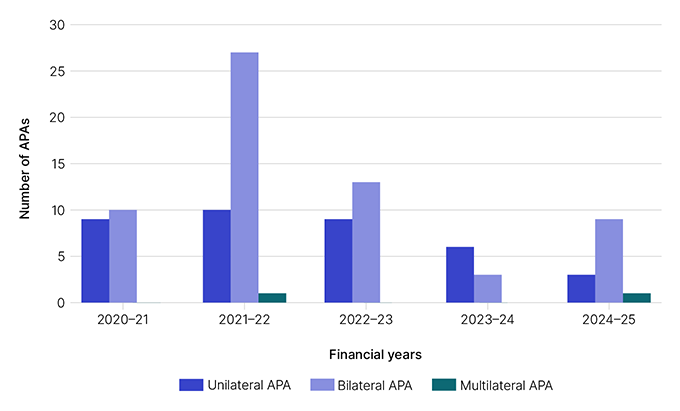
You can also view data for APA Renewal EE requests Table 8.
Figure 29: APA New EE requests
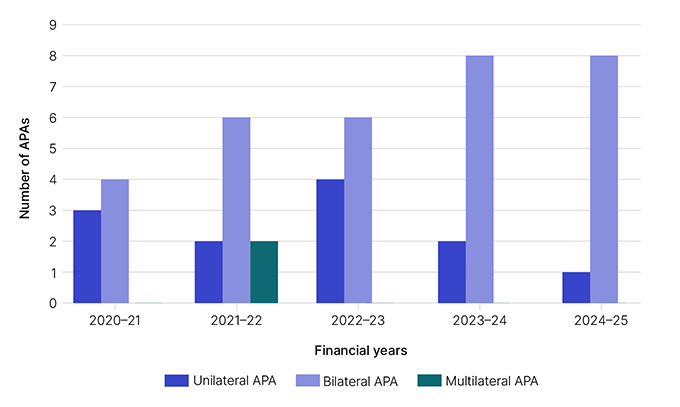
You can also view data for APA New EE requests in Table 9.
Consistent with the above APA inventory analysis illustrating the taxpayers' preference for bilateral APAs, we are seeing a similar trend in the breakdown of APA requests. While aspects of this trend are organic, the trend is more pronounced following the APA program review as we steer taxpayers towards lodging BAPAs where there is risk of double taxation. These impacts can be seen in:
- new requests – numbers remain consistent but bilateral APAs make up a higher proportion, and
- renewal requests – the reduction in unilateral requests is due to some taxpayers switching to bilateral renewals over prior UAPAs or choosing not to renew UAPAs after weighing up the level of materiality, transaction coverage, investment of resources and alternative forms of certainty.
There is also a fair degree of annual fluctuations in APA requests, which are primarily driven by renewal APA requests, which are usually lodged within 6 months of an existing APA expiring and are usually cyclical in nature (that is, every 5 years per the standard APA term). This cyclical pattern of renewal requests was a driver for the above average number of BAPA renewal requests in 2021–22, which was the result of a deliberate strategy between Australia and one of our treaty partners to more efficiently manage and conclude the respective country APA portfolio, providing earlier certainty and an enhanced client experience.
APAs completed
Figure 30: APAs signed by type
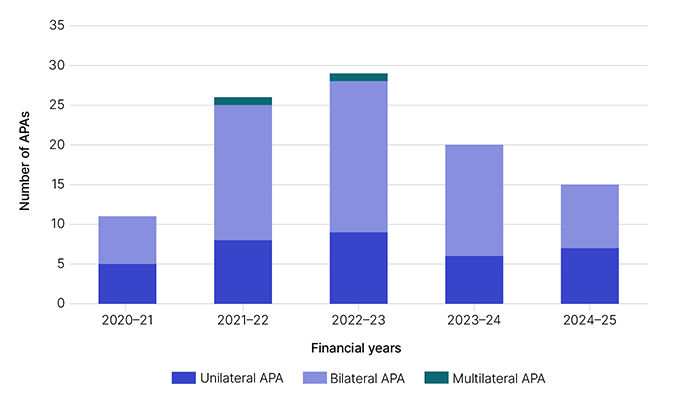
You can also view data for APAs signed by type in Table 10.
Figure 31: APAs signed by New/Renewal
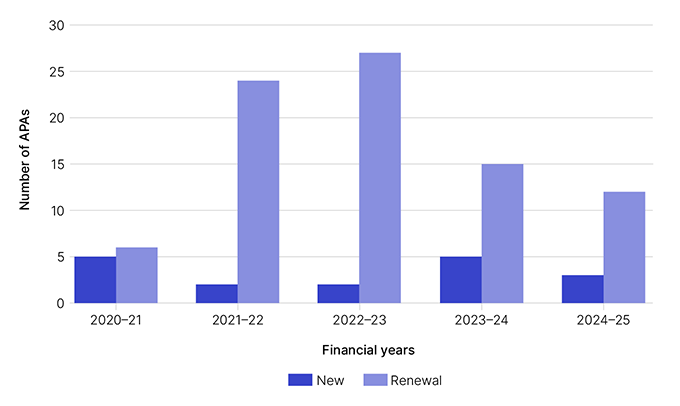
You can also view data for APAs signed in Table 11.
Total number of APAs completed each financial year in recent years has been impacted by a combination of factors stemming from the COVID-19 pandemic, including but not limited to:
- clients delaying engagement with us where their business operations were affected by restrictions or measures to safeguard employees’ safety
- our treaty partners facing similar challenges, in addition to travel restrictions leading to some delays in bilateral negotiations
- capacity or resource issues within the ATO, as some case team staff were redirected to assist with COVID relief programs.
This resulted in unusually low number of APAs completed in 2020–21, followed by a corresponding increase in the number of cases signed in 2021–22 and 2022–23.
Figure 32: Average cycle time for completed APAs by type (UAPA and BAPAs)
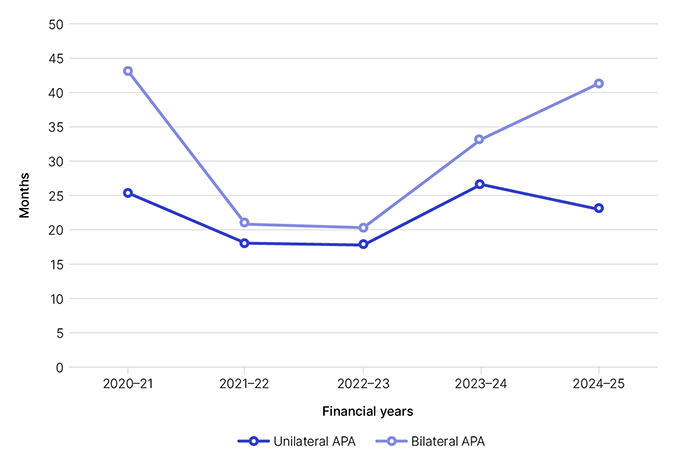
You can also view data for average cycle time for completed APAs by type in Table 12.
Figure 33: Average cycle time for completed APAs by New/Renewal (UAPA and BAPAs)
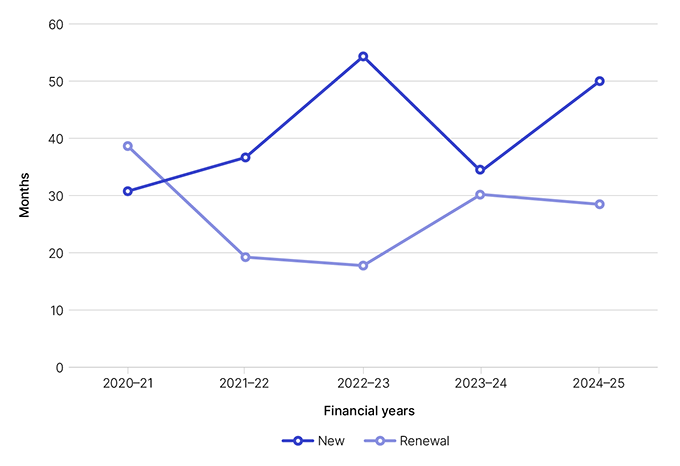
You can also view data for average cycle time for completed APAs by New/Renewal in Table 13.
Our average cycle time data, calculated as the average number of months taken between when a taxpayer lodges their formal application (post-acceptance) to when the APA is signed, is influenced by whether it is a UAPA versus BAPA, and whether it is a renewal or new APA entrant:
- UAPAs are usually completed in fewer months on average than BAPAs, and
- renewal requests are completed faster on average than new requests, with the ATO and our treaty partners able to leverage existing information when completing renewal requests.
Additional impacts to cycle times include factors such as the complexity of the APA (including taxpayer’s industry, corporate structure and transactions), as well as the number and complexity of collateral issues.
We can see that cycle times for the most 2 recent financial years have increased, which can be partially explained by a number of older APAs being completed that were aged due to a combination of:
- the distortive effects of COVID-19, which continue to be represented in our data due to many cases that were put on hold during 2020–21 and 2021–22 due to capacity and resourcing issues for our taxpayers, the ATO, and our treaty partners
- delays due to protracted analyses of collateral issues; this was addressed in the APA program review, resulting in a prescribed framework being recommended and implemented to address collateral issues moving forward.
Figure 34 (Table): Top largest jurisdiction by number of APAs signed between 1 July 2020 to 30 June 2025
|
Country
|
Number of APAs signed
|
Average cycle time
|
|
Japan
|
38
|
18.47
|
|
United States
|
5
|
45.05
|
|
Switzerland
|
4
|
40.99
|
|
New Zealand
|
4
|
25.59
|
|
Korea
|
4
|
32.9
|
Average bilateral APA cycle times at the jurisdictional level are influenced by the size of the APA program inventory with our treaty partner, as well as the types of cases and complexities or collateral issues within each inventory.
As previously mentioned, Japan remains our largest APA treaty partner and one who we have a longstanding relationship with. Accordingly, many cases with Japan are renewal APAs, which allows us to complete the cases on a more efficient basis.
